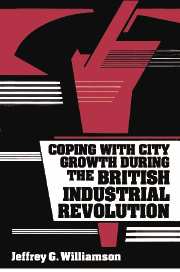Book contents
- Frontmatter
- Contents
- List of tables
- List of figures
- Acknowledgments
- 1 Coping with city growth, past and present
- 2 The urban demographic transition: Births, deaths, and immigration
- 3 Migrant selectivity, brain drain, and human capital transfers
- 4 The demand for labor and immigrant absorption off the farm
- 5 Absorbing the city immigrants
- 6 The impact of the Irish on British labor markets
- 7 Did British labor markets fail during the industrial revolution?
- 8 Did Britain's cities grow too fast?
- 9 City housing, density, disamenities, and death
- 10 Did Britain underinvest in its cities?
- References
- Index
3 - Migrant selectivity, brain drain, and human capital transfers
Published online by Cambridge University Press: 03 May 2010
- Frontmatter
- Contents
- List of tables
- List of figures
- Acknowledgments
- 1 Coping with city growth, past and present
- 2 The urban demographic transition: Births, deaths, and immigration
- 3 Migrant selectivity, brain drain, and human capital transfers
- 4 The demand for labor and immigrant absorption off the farm
- 5 Absorbing the city immigrants
- 6 The impact of the Irish on British labor markets
- 7 Did British labor markets fail during the industrial revolution?
- 8 Did Britain's cities grow too fast?
- 9 City housing, density, disamenities, and death
- 10 Did Britain underinvest in its cities?
- References
- Index
Summary
Introduction
Although some cities grow without industry and some industries grow outside of cities, modern industrialization tends to be city-based. As a result, industrial revolutionary events tend to augment the demand for labor and capital in the city far more rapidly than in the countryside. Labor and capital supplies, on the other hand, tend to be abundant in rural areas, a result of centuries of gradual agrarian-based preindustrial development. One of the fundamental problems created by industrial revolutions is, therefore, to reconcile excess factor demands in the cities with excess factor supplies in the countryside. How do labor and capital markets cope with the disequilibrium?
This question is as old as the British industrial revolution itself. Indeed, the previous chapter was motivated by the same question in which we identified the size of the population transfers that took place between countryside and city from the 1780s to well into the mid-Victorian era. City immigration rates turn out to have been high even by the standards of the contemporary Third World. The same was true of rural emigration. We also identified a selectivity bias in those migrations, young adults favoring the cities, leaving children and elderly dependents behind.
Those young-adult migrations implied a human capital transfer because, as a consequence, the cities needed to invest less in rearing children to adulthood. As Melvin Reder pointed out some time ago, “it is cheaper to import workers than to grow them” (Reder, 1963, p. 224), because, after all, the costs of child rearing are borne by the area of origin.
- Type
- Chapter
- Information
- Publisher: Cambridge University PressPrint publication year: 1990



